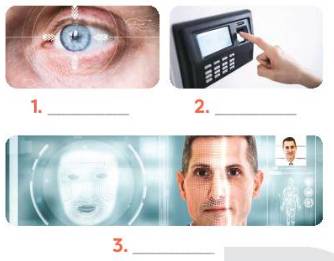Work in pairs. Name the technological applications in the pictures. Can they be used in schools?

Work in pairs. Name the technological applications in the pictures. Can they be used in schools?

Read the texts and tick (v) B (Biometrics) or N (Nanolearning).
Biometrics
No more worries about truancy and cheating! Just introduce biometric applications at your school. With fingerprint scanners, or facial or voice recognition technologies, schools will be able to check students’ attendance. Teachers will no longer need to call students’ names to find out who is absent. This will make more time for activities!
Schools can also use these biometric applications for students who borrow books and equipment. Even more amazing, teachers can even use the eye-tracking applications to check students’ understanding of a lesson and to motivate students to learn.
For more information, visit www.biometricappsolution.com
Nanolearning
Tired of sitting in front of a computer all day long? Unable to concentrate for very long in your classes? Or frequently forgetting large amounts of information? The solution to these is Nanolearning created by Junglemap in 2006.
Nanolearning provides you with small amounts of information over a short period of time. Your learning will become effortless.
Believe us! Receive bits of information within two to five minutes via our platform, and you will increase your learning attention and ability. Our app also reports your study activities and results to your teacher.
| Benefits | B | N |
| 1. It maks learning effortless. | ||
| 2. It checks students' understanding of the lessons. | ||
| 3. Students use it when they brrow books and equipment. | ||
| 4. It helps increase students' learning attention. | ||
| 5. It records students' study activities and results. |
Read the texts again and choose the correct answer A, B, or C.
1. What does checking students’ attendance mean?
A. Checking their presence.
B. Scanning their faces.
C. Checking their fingerprints.
2. With Nanolearning students can ____________.
A. access large amounts of information
B. improve their learning quality
C. concentrate longer
3. What DOESN'T Nanolearning do?
A. Provide a platform.
B. Report students’ results.
C. Entertain students.
4. The texts are from ___________.
A. science books
B. advertisements
C. manuals
1. A
2. B
3. C
4. B
Work in pairs. Discuss and match the questions in A with the answers in B, and then make a conversation about an invention.
| A | B |
1. What invention? 2. Who invented it? 3. When invented? 4. What benefit? | a. Alphone Bertillon b. Check identities of people at airports or offices c. Biometrics d. 1800s e. Check students attendance |
Example:
A: What invention do you like?
B: I like biometrics.
A: Who invented it?
B: Alphonse Bertillon.
Tham khảo
A: What invention do you like?
(Bạn thích phát minh nào?)
B: I like biometrics.
(Mình thích sinh trắc học.)
A: Who invented it?
(Ai sáng tạo ra nó?)
B: Alphonse Bertillon.
A: When did biometrics invented?
(Sinh trắc học ra đời khi nào.)
B: Biometrics invented in 1800s.
(Sinh trắc học ra đời vào đầu thế kỉ 19.)
A: What are the benefits of biometrics?
(Lợi ích của sinh trắc học là gì?)
B: Check identities of people at airports or offices and check students attendance.
(Kiểm tra danh tính của du khách ở sân bay và điểm danh học sinh.)
Trả lời bởi Nguyễn Việt DũngWork in groups. Ask and answer questions about a technology or an invention. Use the example in 4 as a cue. Then report your answers to the class.
Example:
Mi likes biometrics. Alphonse Bertillon invented it in 1800s. It is a very important technology. We use it to ...
Tham khảo
Phong likes biometrics. Alphonse Bertillon invented it in 1800s. It is a very important technology. We use it to check identities of people at airports or offices and check students’ attendance.
Trả lời bởi Nguyễn Việt Dũng
1. eye tracking
2. fingerprint scanner
3. face recognition
Trả lời bởi Gia Linh